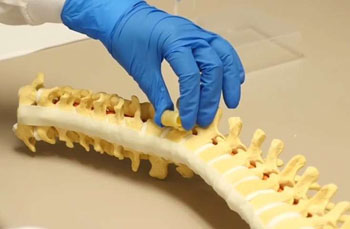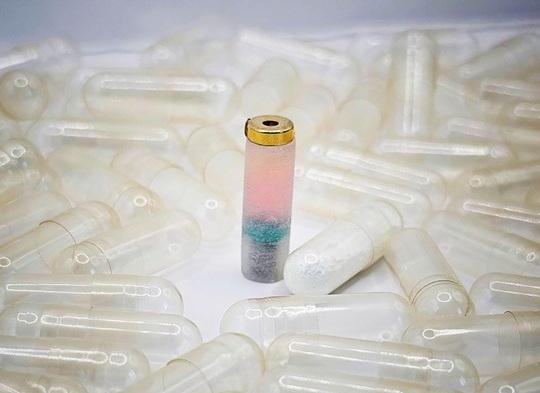Bio-Expandable Bone Graft Could Help Spinal Surgery Patients 
|
By HospiMedica International staff writers Posted on 13 Apr 2016 |

Image: Expanding polymer bone graft to replace excised spinal tissue (Photo courtesy of Dr. Lichin Lu).
An expandable, biodegradable graft could help metastatic spinal tumor patients recover from the surgical removal of bone segments and intervertebral discs, according to a new study.
Researchers at the Mayo Clinic (Rochester, MN, USA) have developed a biodegradable, hydrophilic, polymer graft that when surgically placed in the damaged vertebrae, expands to precisely fill the resected areas by absorbing bodily fluids. The graft is composed of two sections; a hollow hydrophilic scaffold made of crosslinked oligo(poly(ethylene glycol) fumarate) (OPF), and a stabilized polymer filler material. To develop the graft, the researchers first identified a combination of materials that are biocompatible in animals, and which they believe will work in humans.
To control the kinetics of the polymer graft expansion, the researchers made chemical changes to the filler to modify the degree and timing of the expansion, under conditions that mimicked the spinal column environment. The modulation of the molecular weight and charge of the polymer enabled them to tune the material’s properties so that the expansion rate was slow enough to enable surgeons to place it correctly, but fast enough so that it did not extend surgery times. The study was presented at the 251st national meeting & exposition of the American Chemical Society (ACS), held during March 2016 in San Diego (CA, USA).
“The overall goal of this research is to find ways to treat people with metastatic spinal tumors; the spine is the most common site of skeletal metastases in cancer patients, but unlike current treatments, our approach is less invasive and is inexpensive,” said lead author and study presenter Lichun Lu, PhD. “When we designed this expandable tube, we wanted to be able to control the size of the graft so it would fit into the exact space left behind after removing the tumor.”
Related Links:
Mayo Clinic
Researchers at the Mayo Clinic (Rochester, MN, USA) have developed a biodegradable, hydrophilic, polymer graft that when surgically placed in the damaged vertebrae, expands to precisely fill the resected areas by absorbing bodily fluids. The graft is composed of two sections; a hollow hydrophilic scaffold made of crosslinked oligo(poly(ethylene glycol) fumarate) (OPF), and a stabilized polymer filler material. To develop the graft, the researchers first identified a combination of materials that are biocompatible in animals, and which they believe will work in humans.
To control the kinetics of the polymer graft expansion, the researchers made chemical changes to the filler to modify the degree and timing of the expansion, under conditions that mimicked the spinal column environment. The modulation of the molecular weight and charge of the polymer enabled them to tune the material’s properties so that the expansion rate was slow enough to enable surgeons to place it correctly, but fast enough so that it did not extend surgery times. The study was presented at the 251st national meeting & exposition of the American Chemical Society (ACS), held during March 2016 in San Diego (CA, USA).
“The overall goal of this research is to find ways to treat people with metastatic spinal tumors; the spine is the most common site of skeletal metastases in cancer patients, but unlike current treatments, our approach is less invasive and is inexpensive,” said lead author and study presenter Lichun Lu, PhD. “When we designed this expandable tube, we wanted to be able to control the size of the graft so it would fit into the exact space left behind after removing the tumor.”
Related Links:
Mayo Clinic
Latest Surgical Techniques News
- Minimally Invasive Endoscopic Surgery Improves Severe Stroke Outcomes
- Novel Glue Prevents Complications After Breast Cancer Surgery
- Breakthrough Brain Implant Enables Safer and More Precise Drug Delivery
- Bioadhesive Sponge Stops Uncontrolled Internal Bleeding During Surgery
- Revolutionary Nano Bone Material to Accelerate Surgery and Healing
- Superior Orthopedic Implants Combat Infections and Quicken Healing After Surgery
- Laser-Based Technique Eliminates Pancreatic Tumors While Protecting Healthy Tissue
- Surgical Treatment of Severe Carotid Artery Stenosis Benefits Blood-Brain Barrier
- Revolutionary Reusable Duodenoscope Introduces 68-Minute Sterilization
- World's First Transcatheter Smart Implant Monitors and Treats Congestion in Heart Failure
- Hybrid Endoscope Marks Breakthrough in Surgical Visualization
- Robot-Assisted Bronchoscope Diagnoses Tiniest and Hardest to Reach Lung Tumors
- Diamond-Titanium Device Paves Way for Smart Implants that Warn of Disease Progression
- 3D Printable Bio-Active Glass Could Serve as Bone Replacement Material
- Spider-Inspired Magnetic Soft Robots to Perform Minimally Invasive GI Tract Procedures
- Micro Imaging Device Paired with Endoscope Spots Cancers at Earlier Stage
Channels
Critical Care
view channel
Swallowable Pill-Sized Bioprinter Treats GI Tract Injuries
Soft tissue injuries in the gastrointestinal tract, such as ulcers and hemorrhages, are typically treated through invasive surgical procedures that carry high risks and do not always result in permanent repair.... Read more
Personalized Brain “Pacemakers” Could Help Patients with Hard-To-Treat Epilepsy
Epilepsy affects more than 50 million people worldwide, and nearly one-third of them do not respond to available medications. For many patients, seizures originate in brain areas responsible for essential... Read morePatient Care
view channel
Revolutionary Automatic IV-Line Flushing Device to Enhance Infusion Care
More than 80% of in-hospital patients receive intravenous (IV) therapy. Every dose of IV medicine delivered in a small volume (<250 mL) infusion bag should be followed by subsequent flushing to ensure... Read more
VR Training Tool Combats Contamination of Portable Medical Equipment
Healthcare-associated infections (HAIs) impact one in every 31 patients, cause nearly 100,000 deaths each year, and cost USD 28.4 billion in direct medical expenses. Notably, up to 75% of these infections... Read more
Portable Biosensor Platform to Reduce Hospital-Acquired Infections
Approximately 4 million patients in the European Union acquire healthcare-associated infections (HAIs) or nosocomial infections each year, with around 37,000 deaths directly resulting from these infections,... Read moreFirst-Of-Its-Kind Portable Germicidal Light Technology Disinfects High-Touch Clinical Surfaces in Seconds
Reducing healthcare-acquired infections (HAIs) remains a pressing issue within global healthcare systems. In the United States alone, 1.7 million patients contract HAIs annually, leading to approximately... Read moreHealth IT
view channel
Printable Molecule-Selective Nanoparticles Enable Mass Production of Wearable Biosensors
The future of medicine is likely to focus on the personalization of healthcare—understanding exactly what an individual requires and delivering the appropriate combination of nutrients, metabolites, and... Read moreBusiness
view channel
Philips and Masimo Partner to Advance Patient Monitoring Measurement Technologies
Royal Philips (Amsterdam, Netherlands) and Masimo (Irvine, California, USA) have renewed their multi-year strategic collaboration, combining Philips’ expertise in patient monitoring with Masimo’s noninvasive... Read more
B. Braun Acquires Digital Microsurgery Company True Digital Surgery
The high-end microsurgery market in neurosurgery, spine, and ENT is undergoing a significant transformation. Traditional analog microscopes are giving way to digital exoscopes, which provide improved visualization,... Read more
CMEF 2025 to Promote Holistic and High-Quality Development of Medical and Health Industry
The 92nd China International Medical Equipment Fair (CMEF 2025) Autumn Exhibition is scheduled to be held from September 26 to 29 at the China Import and Export Fair Complex (Canton Fair Complex) in Guangzhou.... Read more














